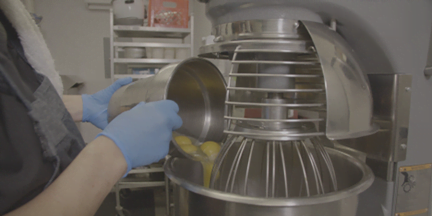For less experienced users, food preparation may be intimidating — especially when it comes to using equipment like mixers, slicers and food processors that they may not be familiar with. That doesn’t have to be the case.
There are some best practices that can make it easier to produce quality results in the kitchen. These can also help operators achieve the efficiencies food prep equipment is intended to bring compared to manual preparation.
Look for equipment with features that simplify training. Keeping recipes consistent can be a challenge, particularly when multiple people are prepping and preparing them. Overmixing doughs, pasta or cake batter, for example, can adversely affect quality. Mixers with digital timers can help avoid this issue and ease training. They are built for mixing multiple batches and doing it consistently. The operator simply sets the timer to minutes and seconds so that the batches turn out the same, every time. These timers also help with recipe creation and executing existing recipes. The timer counts up to determine how long a new recipe needs to be mixed. Or it can count down for existing recipes to guarantee the appropriate mixing time.
Use equipment that is simple to clean. Thoroughly cleaning and sanitizing equipment is an important part of food prep. It helps reduce the risk of food-borne illnesses and ensures high quality food leaves the kitchen. Slicers are a piece of equipment to pay special attention to and there are features that can make cleaning easier. Look for a slicer with a removable blade and components that are easy to remove, allowing for thorough cleaning. Slicers with removable top covers, ring guard covers and a feed grip arm also simplify cleaning, as does a tilt-and-remove carriage.
Rely on available resources. Manufacturers offer valuable resources that can help operators get the most out of their food prep equipment. Take advantage of brochures, spec sheets and operating manuals. Not only do they provide information about the important features and benefits of the equipment, but they also offer guidance on its proper use. Using food prep equipment correctly helps kitchens create quality food. Operator and how-to videos are also very helpful, as these provide hands-on demonstrations for equipment usage.
Find equipment that offers versatility. Having a single piece of equipment that performs multiple functions can make food prep easier and more efficient. Consider a continuous-feed food processor that can slice, dice, grate and shred ingredients. It can be used for fruits, vegetables, nuts and cheese, so it supports the production of many menu items. Another way to gain versatility from one piece of equipment is to add attachments like a vegetable slicer or a meat and food chopper to a mixer.
Seek out operator assurance. Some food prep equipment can be intimidating to use at first. That’s why equipment that operators feel confident using is an important part of food preparation. It helps introduce efficiencies and offer peace of mind. Mixers with interlock systems prevent the mixer from operating unless the user has put the bowl fully up and locked in in place with the bowl guard secured. An encased blade on slicers offers zero knife exposure to protect the operator during cleaning and sharpening.
Remember, food preparation comes down to consistency and quality — using the right equipment and using it properly can help even newer operators gain the best results.



